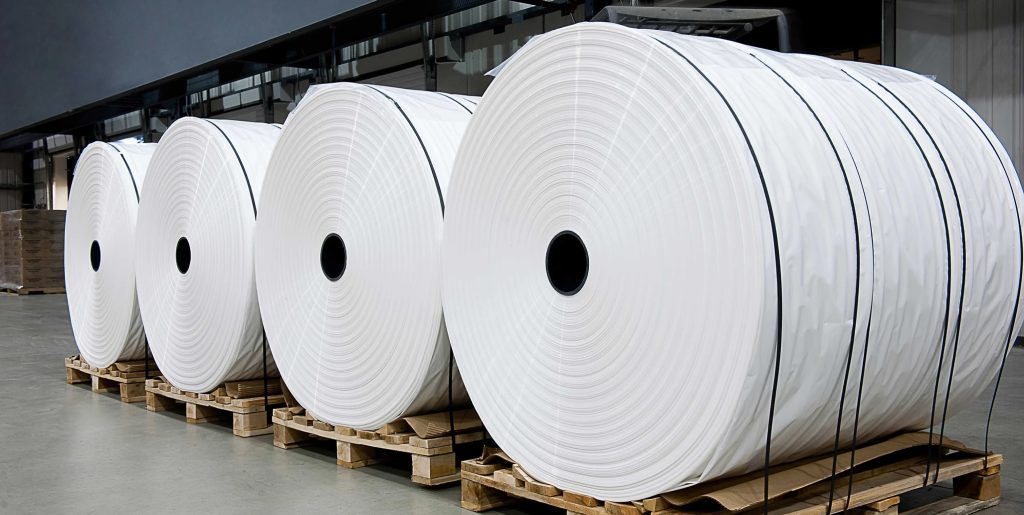
“Why should feed manufacturers prioritize customization in FFS roll woven bags?”
The answer lies in three critical advantages: cost-efficiency through bulk production, superior load-bearing capacity (up to 50 kg), and enhanced product safety via anti-microbial and breathable designs. These factors position VidePak’s FFS roll woven bags as a strategic tool for optimizing feed packaging across poultry, livestock, and pet food industries.
1. Application-Specific Advantages of FFS Roll Woven Bags
1.1 Cost Efficiency and Scalability
FFS (Form-Fill-Seal) roll woven bags streamline production by integrating forming, filling, and sealing into a single automated process. VidePak’s high-speed Starlinger equipment enables the production of over 100 million bags annually, reducing per-unit costs by 15–20% compared to traditional stitching methods. For example, poultry feed producers can leverage bulk customization to align bag sizes (e.g., 10–50 kg) with farm consumption rates, minimizing waste.
1.2 Load-Bearing and Durability
Polypropylene (PP) woven fabrics offer tensile strengths of 8–12 N/mm², ensuring structural integrity even under dynamic transport conditions. In trials, VidePak’s 90 g/m² bags with laminated coatings demonstrated zero ruptures during 1,500 km trucking simulations for cattle feed, outperforming non-woven alternatives.
1.3 Safety and Preservation
Feed spoilage due to moisture and microbial growth costs the global industry $2.3 billion annually (FMI, 2023). VidePak addresses this by:
- Anti-fungal treatments: Inner liners coated with food-grade PE inhibit mold growth.
- Controlled breathability: Micro-perforations (≤5 µm pores) reduce condensation while blocking pathogens.
- UV-resistant outer layers: Critical for outdoor storage of pig feed in tropical climates.
2. Technical Parameters for Optimal Customization
Selecting the right specifications ensures performance alignment with application needs:
| Parameter | Considerations | Recommended Range |
|---|---|---|
| Thickness | Thicker layers (≥0.12 mm) for abrasive feeds like minerals in poultry supplements | 0.08–0.15 mm |
| Grammage | Higher grammage (≥100 g/m²) for heavy-duty livestock feed | 70–120 g/m² |
| Size | Align with automated filling systems (e.g., 50 cm width for pet food lines) | 30–100 cm (width), 50–150 cm (height) |
| Lamination | BOPP lamination for moisture-sensitive fish feed | Optional PE/PP coatings |
| Inner Liners | Multi-layer liners for hygroscopic ingredients (e.g., soybean meal) | 2–4 layers |
3. VidePak’s Competitive Edge
3.1 Advanced Manufacturing Capabilities
With 100+ circular looms and 30 lamination machines, VidePak supports rapid prototyping and large-scale orders. For instance, a recent project for a U.S. pet food brand involved delivering 5 million custom-printed bags (25 kg capacity, BOPP laminated) within 45 days—a feat enabled by modular production lines.
3.2 Sustainability Alignment
VidePak’s recyclable PP bags reduce carbon footprints by 40% compared to multi-material packaging. Collaborations with European agrochemical firms highlight their compliance with EU REACH and FDA standards.
4. Market Trends and Strategic Insights
The global polywoven bags market is projected to grow at 4.8% CAGR (2023–2033), driven by demand for automated packaging in the feed sector. Key trends include:
- Smart printing: QR codes for traceability in poultry supply chains.
- Lightweighting: 70 g/m² bags with reinforced seams for cost-sensitive markets.
FAQs
Q1: How does breathability prevent feed spoilage?
A: Controlled airflow reduces humidity buildup, inhibiting mold—critical for poultry feed in humid climates.
Q2: When is outer lamination necessary?
A: Essential for moisture-prone environments (e.g., marine transport of fish feed). Learn more about moisture-proof solutions.
Q3: Can bags withstand freezing temperatures?
A: Yes, VidePak’s PP material retains flexibility at -20°C, ideal for frozen pet food storage.
5. Future Outlook
Innovations like biodegradable PP blends and IoT-enabled batch tracking are reshaping the industry. VidePak’s R&D team is piloting antibacterial nano-coatings to address salmonella risks in poultry feed—a $120 million opportunity by 2027.
For automated packaging workflows, explore VidePak’s FFS roll bags for pet food, designed for speeds of 1,200 bags/hour.
In Conclusion
Customized FFS roll woven bags are not just packaging—they are a strategic asset for feed producers. By aligning technical parameters with operational needs and leveraging VidePak’s scalable solutions, businesses can achieve 20–30% efficiency gains in packaging logistics while ensuring product integrity.